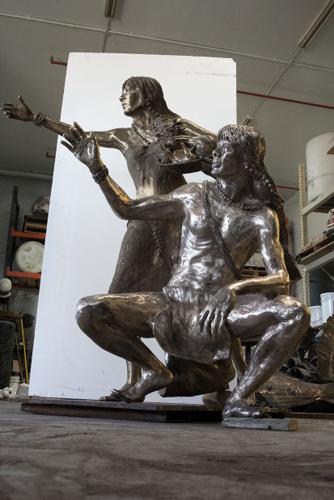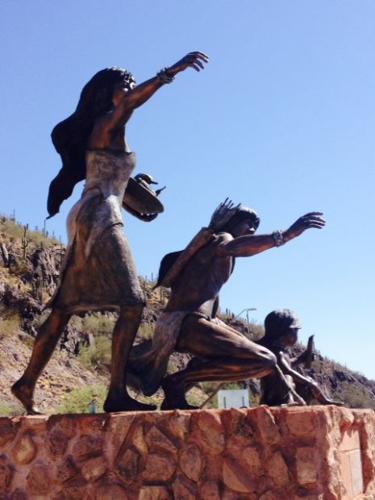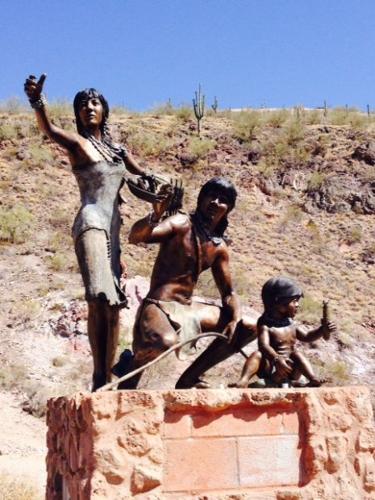About 15 years ago several Tucsonans came up with an idea to honor our region’s indigenous ancestors. It would be a statue, somewhere at the foot of Sentinel Peak, where a Pima village existed when the first Europeans arrived in the late 17th century.
The proposed statue went nowhere. The idea, however, persisted and its dreamers refused to give up.
That perseverance resulted in a monument to the Tohono O’odham, a bronze statue called “La Primera Vista.” The statue, created by Tucsonense Luis Mena, recognizes our region’s original inhabitants. The name and the statue itself, a man, woman and child, reflect the sighting of the 1692 arrival of Padre Eusebio Francisco Kino, who was likely the first European to arrive in Chuk Son, the “spring at the base of the black mountain.”
“It is a fulfillment of a long-held desire,” said Greg Hart, one of the individuals who initiated the project along with Josefina Cárdenas, a resident from nearby Barrio Kroger Lane, and the late Daniel Preston, a former vice chairman of the San Xavier District of the Tohono O’odham Nation.
On June 14 the statue will be dedicated in a public ceremony at 9 a.m. The statue is at South Mission and Grande roads, just north of Starr Pass Boulevard, across the way from where the original Spanish convento was built, marking Tucson’s colonial birthplace.
Hart said the statue is one of the few memorials in the Tucson area to pay homage to the native peoples who lived along the Santa Cruz River and in other settlements in the Tucson valley.
“It is so appropriate,” said Hart, former director of adult education in Pima County.
The concept evolved about 1999 through a group called Rancho Chukson, which had promoted building a cultural center at the base of “A” Mountain as part of the Rio Nuevo development on the west side.
Cárdenas, Preston and Hart approached the late Tohono O’odham artist Leonard Chana to draw a sketch of their idea. He did and from that sketch Mena created the statue.
Mena consulted with leaders at the San Xavier District while creating his sculpture, said Raúl Ramírez of Los Descendientes del Presidio de Tucson, a group that assisted in raising money for the $80,000 project.
“We were trying to be as authentic as possible with some artistic license,” Ramírez said.
Originally there were four figures in Chana’s sketch but because of costs, one was eliminated. The woman in the statue is holding a basket of beans, squash and watermelon which the Pimans cultivated along the river. The man is on his haunches holding a bow. The child holds a cob of corn in his left hand.
Both the woman and the man are looking toward the river which Kino, and subsequent colonizers, used to follow up from missions and presidios further south. Their faces exhibit both amazement and apprehension at the arrival of strangers who would alter their lives and the land.
“It turned their world upside down,” Hart said.
Ramirez said Mena, a Tucson artist who has painted a number of murals here, used Tohono O’odham models for his statue.
The bulk of the funds, about $64,000, came from the Regional Transportation Authority, which allocates money for public art projects. The reconstruction of the intersection was a RTA project.
The remaining funds were collected by Hart and Los Descendientes. The county government and the Tucson Pima Arts Council were also involved in the project.
Ramírez and Hart said money for the project has run out but that they hope to find additional money to enhance the monument with benches, night lighting and parking spaces across the street to make the space visitor friendly.
In addition, Cárdenas said the group is considering creating an annual fall festival at the statue to celebrate Tucson’s birthplace and its original inhabitants.






